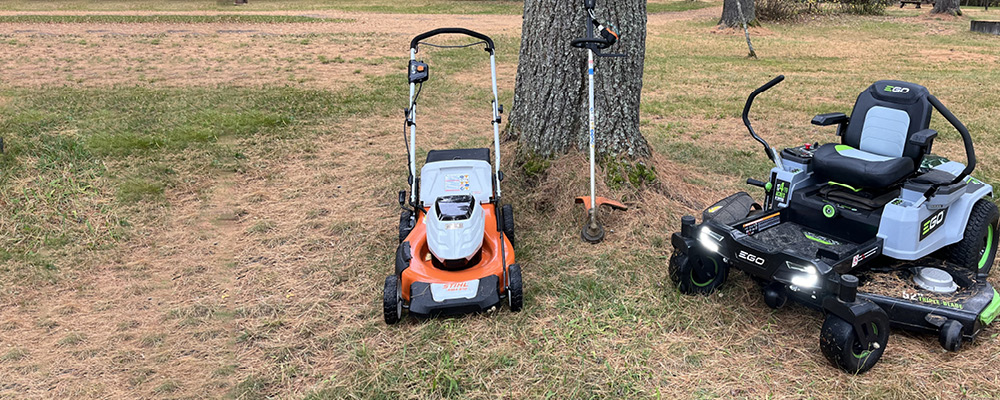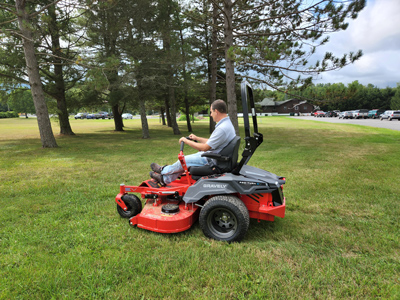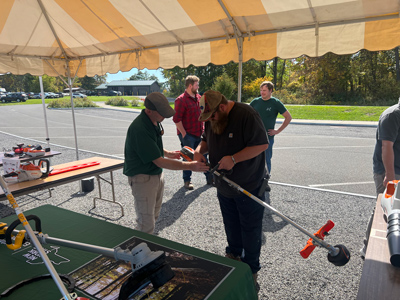Electric Yard Equipment Buyer’s Guide

Cut Costs, Noise, and Emissions When You Go All-Electric
Whether mowing the lawn, taking care of leaves, or clearing a path in the snow, yard work is a year-round chore for many New Yorkers. The outdoor power equipment – lawn mowers, leaf blowers, snow blowers, and the like – used to get the job done are becoming increasingly electric.
Electric lawn mowers are over 65% of the U.S. market share, with an expected annual growth rate of 7.3% through 2032 [1]. The Home Depot anticipates that more than 85% of outdoor power equipment sales will be rechargeable battery models by 2028 [2]. While the shift from roaring gas-powered yard equipment to all-electric models may be quiet, the health benefits, environmental impact, and long-term cost savings are notable.
All-electric equipment is far less noisy when operating. Whereas gas-powered equipment produces harmful levels of noise pollution that’s not only a nuisance to neighbors, but increases the risk of hearing loss, strokes, and heart attacks from both short- and long-term exposure [3].
Going electric also eliminates the smell of gas and associated emissions. For instance, operating a commercial leaf blower for one hour emits the equivalent air pollution of driving a new passenger vehicle for around 1,100 miles [4]. Electric equipment also offers easier maintenance and lower operating costs.
Ready to ditch the gas can? This guide will cover everything you need to know about electrifying your yard equipment, from the available technologies to equipment maintenance and what to consider when comparing options.
Types of Electric Yard Equipment


Ride-on mower at DEC Regional Office
Electric yard equipment is available for residential and commercial uses, as well as plug-in and battery-powered designs. However, most modern models are the cordless, rechargeable variety.
Here’s an overview of the types of all-electric yard equipment available for residential and commercial use.
- Electric lawn mowers: Available in push, self-propelled, and ride-on corded and cordless options, with typical run times of 30-70 minutes on a single charge.
- Electric leaf blowers: Available in handheld or backpack models – both corded and cordless – with a typical run time of up to 30 minutes [5]
- Electric snow blowers: Available as corded or battery-powered models, with battery life typically lasting for 45 minutes.
- Electric trimmers / weedwhackers: Available in corded and battery-powered designs, with typical run times of about 30 minutes on a single charge [6].
- Electric chainsaws: Available as corded and battery-powered models, with battery life usually lasting 30-40 minutes of continuous use.
What to Consider When Making the Switch
Electric yard equipment provides a range of benefits and comparable (if not superior) performance to gas-powered models. Although the upfront cost of all-electric equipment can be higher, the lifetime cost of ownership is often less than gas equipment due to reduced maintenance and operating costs.
Here are some tips to make the switch to electric both cost-effective and aligned with your outdoor equipment needs.
1. Assess Your Needs to Determine Battery Capacity
Bigger isn’t always better. It’s important to consider where and how you’ll use electric outdoor equipment to determine the ideal size, design, and battery capacity. Electric corded models, for instance, are best suited for compact outdoor areas that have some proximity to an outlet.
When choosing a battery-powered electric model, thinking about how long it usually takes you to complete a given yard chore may be easier than estimating your lawn size or driveway area. Battery-powered electric lawn mowers can run from 30 to 70 minutes on a single charge depending on the model and grass length. If the run time is cutting it close, consider having a second battery to swap in or choosing to mow the front and back lawn on different days.
For most driveways, 45 minutes is sufficient for clearing away snow with a snowblower. Note that most batteries can recharge in 1-2 hours to get back to work outside relatively quickly if needed.
2. Choose One Company and Battery Type
Though you may start your electrification journey with a single piece of equipment, it’s important to evaluate a company’s full suite of battery-powered gear. The rationale here is that companies often standardize their batteries and chargers, allowing them to be interchanged between multiple types of equipment.
Taking this approach can translate to considerable cost savings, as you can buy a second and third piece of equipment without having to buy yet another battery and charger. Having less batteries and chargers also helps save space in your garage, mudroom, or wherever you store power tools and outdoor equipment.
3. Compare Features
With any equipment purchase, it’s good practice to think about the functionality and features that are important to you.
For example, electric mowers are available in self-propelled or hand-push designs. The former takes much of the legwork (literally) out of mowing but comes at a higher cost and requires more power to operate.
The materials used in the yard equipment should also be taken into account. Ponying up for more durable materials (e.g., metal decking instead of plastic on a lawn mower) is an investment in a longer equipment lifespan.
4. Brush Up on Maintenance
Electric equipment requires less maintenance than gas-powered varieties – no spark plug changes or need to drain gas and oil to winterize. But some routine care can extend the equipment’s life and optimize performance.
With any battery-powered equipment, it’s best practice to keep a battery charged and use it regularly (when feasible). Batteries and chargers should be kept indoors where it’s safe from moisture and extreme temperatures between uses.
Otherwise, consult the manufacturer recommendations on the use, charging, and storage of the battery to preserve its life.
Leading by Example in Electrifying Lawn Equipment


DEC hosts an electric lawn equipment event to share best practices
with other NYS agencies.
The New York State Department of Environmental Conservation (DEC) is leading the charge on the transition to zero-emission electric lawn equipment.
The initiative is well underway, with smaller equipment like leaf blowers, chainsaws, and weedwhackers being widely used at DEC properties across the State. DEC is also making progress replacing some of its larger gas-powered equipment with all-electric varieties when they approach the end of useful life. To date, DEC has integrated electric push and riding mowers, golf carts, work carts, snowblowers, and even an all-electric boat into its operations.
Hundreds of staff and millions of New Yorkers who visit DEC campgrounds and day-use areas will feel the impact of this transition. Aside from the quieter and cleaner operations, DEC’s Director of Sustainability, Brendan Woodruff, emphasizes the improved user experience. “They’re much easier to start – no risk of throwing your back out with a pull cord,” says Woodruff. Additionally, the all-electric equipment reduces the need to store oil and gasoline and transport them to the remote areas DEC manages.
“The equipment has proven equal to or better performing than its gas equivalents,” adds Brett Byrne, who works on DEC’s Region 4 Operations team. Byrne’s team has introduced an electric commercial grade mower, electric utility vehicle, and a host of battery-powered handheld equipment at the Five Rivers Environmental Education Center. “Our field crews are now using some of this equipment as well to maintain our forest preserve parking lots, remediation sites, and embankment dams,” notes Byrne.
Byrne also points out some less obvious benefits of using electric equipment. “Electric chainsaws cut faster than the equivalent size gas equipment, and weed trimmers have instant knockdown power without having to ramp up like gas models,” notes Byrne. According to Byrne, there’s less user fatigue operating the lighter electric equipment.
"Transitioning to electric lawn equipment is a true win-win-win. It provides a quieter experience for the public, a better user experience for our staff, and it reduces greenhouse gas emissions. Your yard, and neighbors, will thank you for making the switch."
-Brendan Woodruff, DEC Director of Sustainability
New York municipalities can lead by example in using electric landscaping equipment like lawn mowers and leaf blowers in their communities and earn points towards Clean Energy Communities designation and grant funding for doing so.
More on Electrification
Looking to electrify appliances and equipment for your home or business? Explore the resources below for tips and guidance on getting off fossil fuels – and how to save money when you make the switch.
- All About Heat Pump Water Heaters: Learn how this ultra-efficient, electric equipment is pumping up home energy savings.
- Energy-Saving Home Improvement Ideas: Boost indoor comfort and lower your energy bills with these energy-saving home improvements, including all-electric appliances and clean heating and cooling systems.
- NYS Guide to Inflation Reduction Act Savings: Find out how to combine IRA tax credits and New York State incentives to lower the cost of clean energy equipment and upgrades to your home or business.
- The Buyer’s Guide to Induction Cooktops: From how induction works to choosing the right cooktop, our guide covers all you need to know about the cleaner, safe, and more efficient way to cook.
Footnotes
- Electric Lawn Mower Market. Fact.MR, Market Research Company. (n.d.). https://www.factmr.com/report/811/electric-lawn-mower-market#:~:text=Electric%20Lawn%20Mower%20business%20in,the%20mainstream%20from%20from%20novelty
 . Back to content
. Back to content - The Home Depot sets goal for battery powered products to drive over 85% of outdoor lawn equipment sales by 2028. The Home Depot. (n.d.). https://corporate.homedepot.com/news/sustainability/home-depot-sets-goal-battery-powered-products-drive-over-85-outdoor-lawn
 . Back to content
. Back to content - How noise pollution may harm the heart. Harvard Health. (2020, March 1). https://www.health.harvard.edu/heart-health/how-noise-pollution-may-harm-the-heart
 Back to content
Back to content - California Air Resources Board. SORE - Small Engine Fact Sheet | California Air Resources Board. (n.d.). https://ww2.arb.ca.gov/resources/fact-sheets/sore-small-engine-fact-sheet
 Back to content
Back to content - Hope, P. (n.d.). Best Leaf Blower Buying Guide. Consumer Reports. https://www.consumerreports.org/home-garden/leaf-blowers/buying-guide/
 Back to content
Back to content - Best string trimmer buying guide. Consumer Reports. (n.d.). https://www.consumerreports.org/home-garden/string-trimmers/buying-guide/
 Back to content
Back to content
Sign Up For News
Stay up to date on energy-saving programs and incentives, best practices, and more.
Stay Connected